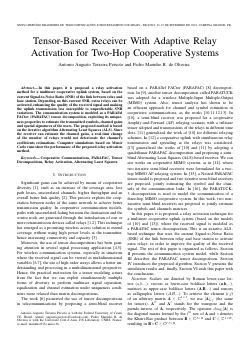
Tensor-Based Receiver With Adaptive Relay Activation for Two-Hop Cooperative Systems
Antonio Augusto Teixeira Peixoto, Pedro Marinho R. de Oliveira
DOI: 10.14209/sbrt.2018.208
Evento: XXXVI Simpósio Brasileiro de Telecomunicações e Processamento de Sinais (SBrT2018)
Keywords: Cooperative Communications PARAFAC Tensor Decompositions Relay Activation Alternating Least Squares
Abstract
In this paper, it is proposed a relay activation method for a multiuser cooperative uplink system, based on the current Signal-to-Noise Ratio (SNR) of the link between relay and base station. Depending on this current SNR, extra relays can be activated, enhancing the quality of the received signal and making the uplink transmission less susceptible to unpredictable SNR variations. The communication system is modeled as a PARAllel FACtor (PARAFAC) tensor decomposition, exploiting its unique- ness properties to estimate the transmitted symbols, channel gains and spatial signatures of the users. The proposed method is based on the iterative algorithm Alternating Least Squares (ALS). Since the receiver can estimate the channel gains, a real-time change of the number of relays would not deteriorate the channel’s coefficients estimations. Computer simulations based on Monte Carlo runs show the performance of the proposed relay activation method.Download